7 Ways To Cook While Camping.
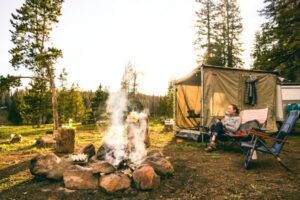
There are plenty of ways to cook while camping. This can range from the elaborate take everything, even the pizza oven and kitchen sink method, to the basic backpacking twig stove.
What cooking equipment to take and method to use, will depend on the type of camping you are doing?
Have you got a campervan, or trailer with plenty of room for cooking gear?
Maybe you are car camping. So you still can take some bigger cooking items, but you have to be aware of how much space for packing you have?
Or perhaps are you backpacking, or doing the minimalist survival and bushcraft camp cooking? Where you have to have light weight cooking equipment or minimal items.
So let’s go over a few ways to cook while camping. You might even discover, or try a new method of cooking that you may not have thought about. Plus some pros and cons of each camping cooking method.

Types of camping stoves and cooking methods.
Here is a list of cooking methods and equipment while camping, that you might choose from.
- Alcohol stoves.
- Backpacking canister stoves.
- Portable camp stoves.
- Twig stove.
- Hexamine stove.
- Cast iron pot.
- Camp fire.
Ways To Cook While Camping.
Let’s go through each cooking method with a bit more information.
- Alcohol stoves.
Spirit or alcohol stoves are very versatile and most are light weight.
Stoves like the Trangia Spirit Burner or similar types have no, or minimal working parts. So not a lot can go wrong with them and are good for camping conditions.
The alcohol burner uses spirits or alcohol based fuels. Ethanol’s and spirits with 70 % alcohol or over will work. (Heet, isopropyl alcohol, methylated spirits, etc.)
Some spirit stoves come with a complete cooking set. Which includes pots, wind shield / base, stove and nesting dishes.
Other individual stoves you buy will need a wind shield and some spirit stoves will need a base to put the pots on it, above the flame.
One of the biggest draw backs of the alcohol stoves is carrying the extra fuel. (I suppose this could be said for butane and gas canisters though as well.)
Too work out how much fuel you need for a meal, or for boiling water, test the stove out first at home.
You can then workout how much fuel you need if you are going on a backpacking trip for two days.
Include your coffees, teas and hot snacks in the calculations.
If it is going to be your first hiking trip, take some meals that can be eaten cold as well as hot. In case you miscalculate the amount of fuel needed. It is no fun hiking on a growling stomach.
Depending on the fuel used, one tip so the pots don’t get sooty and black is to put a teaspoon of water in the fuel when it is poured. (Don’t put the water in while the stove is going.)
A safety concern with alcohol stoves is the flame is very hard to see. So be careful when lighting the stove, as you think it may not be going. Keep the fuel container away from the flame in case it accidentally gets knocked over.
Spirit stoves are reasonable priced and you can get some great bargains if you shop around.
Ferrocerium rods, (Known as ferro rods.) that throw sparks, are a good lighter for the spirit stoves. As you don’t have to get your hands close the fuel, like a Bic lighter.
If you are finished cooking with the stove, but it is still going, use the cap to snuff out the flame.
- Backpacking canister stoves.
Canister backpacking stoves are ideal for lightweight hikers and backpackers who want a quick way of heating up meals. For boiling up water, the fuel canisters stoves are very fast.
These stoves might use propane or isobutene canister and you can adjust the cooking flame and heat.
Most come with an inbuilt ignitor button or switch. (For a backup ignition source, still takes some matches and a lighter.)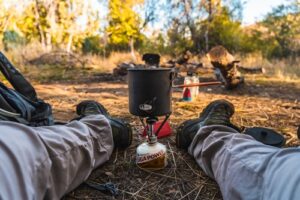
The canister stoves go well with dehydrated and dry freeze meals, were you just add boiling water.
Some models are top heavy and need a wide base, but the better models are well designed and also have a built in wind shield. You can even get a coffee press for some.
Titanium, micro and lightweight models with nesting cups designed to work with them are getting more popular. Some popular brands are the Jetboil and MSR stoves with the complete cooking systems.
One drawback about these stoves is that the can be very expensive and the changeable canisters might be hard to find for certain brands.
- Portable camping and burner stoves.
The gas, propane and butane stoves are a good choice for car camping or trailer parks and the outdoors.
The adjustable burner settings, make easy work from everything from boiling water for a brew, to cooking multiple courses on different heat settings.
A lot of the camping gas stoves have built in side wind shields.
Stoves with multiple burners are good for cooking multiple items at once, like the Coleman Gas 2 Burner Camping Stove or similar models are worth checking them out.
If you have the room when travelling and camping and need a lot of control when cooking, the multi burners are good cooking stoves.
Have some spare butane or gas canisters, in case you run out while cooking.
- Twig stove.
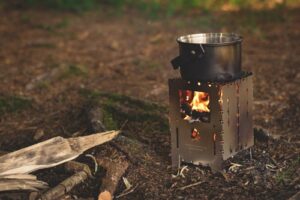
The twig stove is probably one of the simplest stoves there is for camp cooking. (Apart from the open campfire.)
With some twig stove designs you simply fold them up. Or others you might use a kidney shaped cup, like the military uses to nest in the stove.
An advantage of the twig stove is you just use kindling, leaves, twigs, etc. for fuel. In heavily wooded areas you should never run out of fuel, unlike a canister model stove.
Some draw backs of this stove are that for areas that don’t allow an open flame you may not be allowed to use it. Or for very hot windy days a bush fire is a concern, it shouldn’t be used.
- Hexamine stove.
 The hexamine stove, or its nickname the hexi stove is a simple no fuss stove.
The hexamine stove, or its nickname the hexi stove is a simple no fuss stove.
It uses compressed fuel tablets that you light with a match or lighter.
The amount of tablets needed to boil water will depend on the size of the tablets. Some are big squares that one tablet will cook a meal with. With other smaller tablets you might need four tablets.
Some military originations around the world use the hexamine stove, because it is lightweight, easy and quick to use. (And also cheap to produce.)
For transport, the hexi stove can store the fuel tablets inside the closed position.
Another way to cook while camping is to turn the hexamine stove upside down. This gives a base for a pot you can also burn twigs underneath it, saving on fuel tablets.
One drawback is the hexamine stove isn’t as quick for boiling water as a backpacking stove like a Jetboil or MSR type stoves.
The hexi stove is a lightweight and easy to use stove. It is also cheap to buy and a good option for the minimalist camper or hiker.
- Cast iron pot.
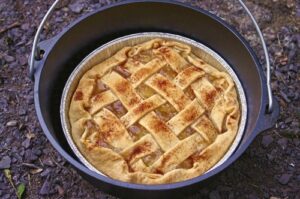
The camp oven, Dutch oven, or cast iron pot is a great way of cooking for larger groups of people when camping.
Some of the most amazing roast and stews I have ever had were the camp oven meals. Like roast duck, rabbit stew, roast pork and venison to name a few. Roast potatoes, pumpkin and carrot go well with game meats and roast cuts.
You do have to be careful you don’t drop or crack the pot.
One drawback of cooking with the camp oven is that you do have to have enough heat for the initial fire, to heat up items and it does take a bit of time.
If you have a big camping group, one person might attend and watch the fire, while the other groups can go off fishing, hiking and exploring.
It is heavy and large, and only designed for car camping or large base camps, but the cast iron pot can cook up some amazing camping meals.
- The camp fire.
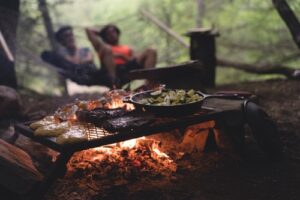
For camp cooking, there is no better method then the open campfire for me, because of its simplicity.
Cooking with skillets, fry pans, wire grill or a hot plate directly on the fire is a great way to enjoy food in the outdoors.
Bacon and eggs cooked over the campfire, a thick juicy steak with grilled onions is one of life pleasures.
Camping meals in foil also opens up a whole new world to cooking.
Simply place the food item in the foil parcel and throw in the fire. Well maybe not that simple, but it pretty easy. (And low cleaning up and minimal dishes is what I like.)
You can cook baked potato, trout with lemon, or bannock, (Damper.) meals in foil. Even desserts, pudding and sweets can be cooked in foil with the campfire.
Side dishes in foil, like fire baked pumpkin and carrots in seasoning are delicious in a foil parcel.
One big disadvantage for cooking with the fire, is that it is hard to control the heat.
The best tip for cooking on the fire, is to let the flames go down to coals and white coals for cooking. The old saying flames for boiling and coals for cooking is true. So you might have to start the fire early.
Maybe allow an hour or so, until the wood has burnt down and there are coals. This will depend on the size of your fire.
Also different woods will give of different heat and burning times. As an example, pine will burn brightly and quickly giving of a high initial heat when cooking. Harder woods might give off a longer heat.
You can even practice survival cooking and just use flat rocks for cooking. Or directly place the food item into the white coals and ash. (Yum, cooked grasshoppers, frogs and scorpions.)
The open campfire has a lot of safety concerns though. Such as, it may not be suitable for inexperienced campers with young children, or for hot days.
How to cook while camping.
Tips.
Weight, portability, value, dependability and ease of operation should be considered when selecting a cooking stove.
Also the way you are going to cook will depend on your stove choice. Are you going to be doing lightweight hiking in summer, a day trip or car camping in winter?
Have extra water with you, so you can wash prepare and cook the meals. Some camping meals require a lot of water for cooking, such as pastas, rice, etc.
Also cleaning up and washing the pot and plate requires some extra water.
For cleaning the plates, try to scrape up the leftovers on the plate. Use bread or pita breads to wipe up and eat the bits of stews, etc. on the plate.
Some clean sand, or not toxic plants can help wipe the excess food of the cooking equipment.
If you do cook up a stew or hot pot and there is some left over juices and food, you might add some water to it and use it for a soup. Add some beef stock cubes or bouillon stock cubes and you have an easy soup prepared. Just don’t tell the children it was leftovers from the last meal.
Extra-long tongs, cooking utensils are handy for keeping away from the hot flames and stoves while cooking. Long stirring spoons and extended marshmallow sticks make life easy.
Click on Ideas For Camping Meals for some camping recipes.
Camp cooking safety.
Have a first aid kit as it can be easy to burn yourself if you are not used to the cooking method or equipment while camping. Stay safe camping and cooking.
Keep oils or cooking spray away from the open flame. Otherwise they could get knocked over accidentally and pour into the fire.
Follow the camping ground rules. Allot of parks and camping grounds may not permit an open flame, so do your homework and know what is allowed for cooking.
For hot, dry and windy days, the campfire and open flames shouldn’t be used. As embers can travel miles and start forest fires easily.
For cooking areas make sure there are no combustible materials close by. Like leaves and foliage and don’t cook close to the tent or near materials.
Be safe and always triple check the fire is out properly.
Conclusion. – Ways to cook while camping.
Camping and camp cooking, what a great combination. Having a nice meal after a hard day hiking, fishing or just spending time with the family outdoors is a great way to enjoy the outdoors.
Form the simple camp fire to the latest high tech lightweight backpacking stove, there are plenty of ways to cook while camping and methods to use and experiment with.
I hope you enjoyed the article about some popular cooking methods and gear for camping.
Appreciate the outdoors and happy cooking.



